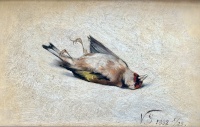Vastagh, Géza Goldfinch

Current auction
In case of questions please ask:
Details
Description
Behind the apparent simplicity of this small still life lies a finely balanced study of transience, natural observation, and quiet drama. Vastagh Géza, renowned for his animal depictions, does not present the dead goldfinch as a hunting trophy but as a solitary, almost intimate motif—marking a deliberate departure from the opulent tradition of game still lifes toward a more contemplative, almost scientific gaze.
The composition is radically reduced: no accessories, no background, no sign of human presence. The bird lies on a light, textured surface, making the vivid colors of its plumage—red, yellow, and black—stand out with even greater intensity. This complete removal from any narrative context shifts the image into a symbolic space: the small body becomes a memento mori, a reminder of the fragility of life.
At the same time, the goldfinch evokes a long iconographic tradition. In Christian art, it symbolized the Passion of Christ, as legend holds that the bird stained its feathers with the blood of the crown of thorns while trying to comfort the crucified Christ. Although Vastagh provides no explicitly religious setting, the contrast between the delicate body and the bright red head would have resonated with this layer of meaning for many contemporary viewers.
Thus, the painting combines naturalistic precision with a restrained poetic depth. Vastagh depicts not merely an animal but the end of a life—without pathos, yet with profound sensitivity. In its austerity, the work feels almost modern: surprisingly focused and imbued with a quiet emotional charge that transcends the conventions of animal still life.



